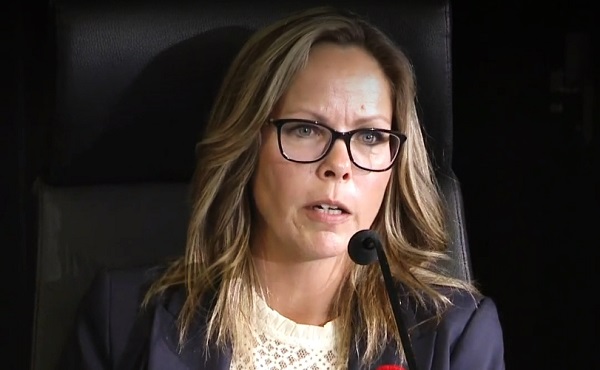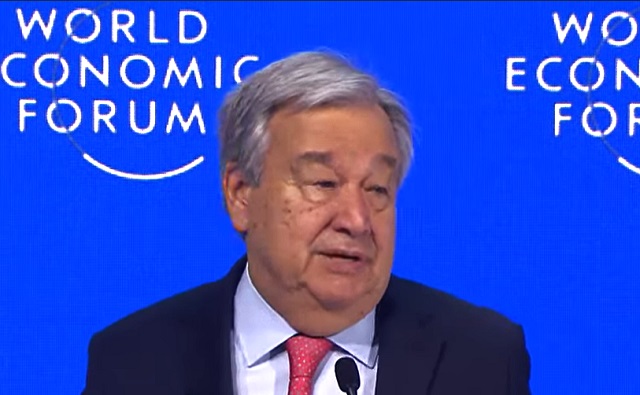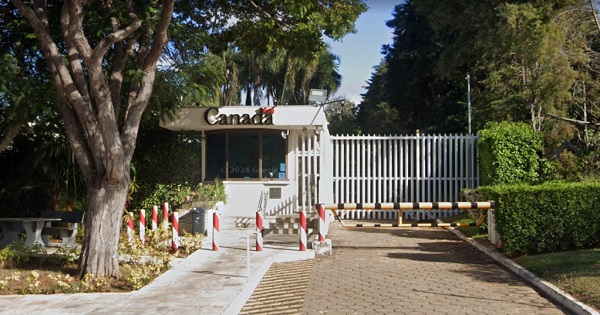Break The Needle
New drug cartel terrorist designations raise legal risks for Canadian banks

By Alexandra Keeler
In October 2024, the U.S. Department of Justice slapped TD Bank, Canada’s second-largest bank, with a $3 billion US fine for failing to stop cartel-linked money laundering.
Canada’s financial institutions could face criminal liability for facilitating transactions tied to cartel-linked drug sales, according to a new report by journalist David Clement.
Clement argues Canada’s recent designation of seven transnational criminal organizations as terrorist entities may implicate banks, credit card companies and Interac under the Criminal Code, due to their role in processing payments for illegal drug sales.
“In Canada, collaborating with a listed terrorist organization is a serious offence under the Criminal Code,” writes Clement in the report.
“It should cause them — the banks and Interac — to take action,” Clement told Canadian Affairs in an interview.
Legal experts say the Criminal Code permits the prosecution of institutions that facilitate terrorism. But the burden of proof is high and the likelihood of charges being laid is low.
“Theoretically, there’s no impediment to [prosecuting financial institutions],” said Anil Kapoor, a criminal and national security lawyer.
“The real question is how you acquire the evidence, and … does the evidence add up to knowingly [facilitating illegal transactions]?”
Terrorist organization
In February, Canada expanded its list of designated terrorist organizations to include seven criminal organizations, most of them powerful drug cartels.
The list includes five Mexican cartels, such as the Cártel de Sinaloa and Cartel de Jalisco Nueva Generación (CJNG), El Salvador’s La Mara Salvatrucha (MS‑13) and Venezuela’s Tren de Aragua.
This designation brings anti-terrorism laws into play for groups previously targeted mainly for drug trafficking. This allows law enforcement to pursue broader charges with harsher penalties and lower thresholds for prosecution.
Clement’s report, published by the advocacy group Consumer Choice Center, warns that banks, credit card companies and Interac could face legal risks for facilitating transactions with online drug vendors linked to these cartels.
However, Clement stops short of identifying any specific institutions as having committed wrongdoing.
Bankrolling cartels
Clement says financial institutions should be required to act on publicly available information about how to purchase illicit substances.
“If I buy from Moon Haus and I buy cocaine, what bank is that deposit going to?” said Clement. Moon Haus is an online Canadian vendor that openly sells illicit psychedelic drugs and accepts payment via e‑Transfer.
A vendor like Moon Haus is not a designated terrorist organization, but its connections to cartel-supplied products could leave financial institutions legally exposed, says Clement.
“A compliance officer at a bank could likely just search for [a Moon Haus] email and see if it’s linked to any of their deposit accounts,” he said.
Legal experts agree that the Criminal Code permits financial institutions to be charged with facilitating terrorism. But the challenge would be proving intent.
There needs to be a deliberate understanding or intention to facilitate terrorist-related transactions for it to be considered “knowingly” aiding terrorism, says Kapoor, who sits on the board of the Canadian Civil Liberties Association and previously served on the Prime Minister’s Advisory Council on National Security.
Jessica Davis, president of Canadian security consultancy Insight Threat Intelligence, says the bar is very high for prosecuting financial institutions for terrorist financing in Canada.
“You’re much more likely to get things like really large fines for [financial institutions] just not doing enough due diligence and not reporting enough,” said Davis, who was formerly a senior analyst with the Canadian Security Intelligence Service.
“Then [law enforcement would] have to meet a very high bar to convince a prosecutor that this was a good use of their time. And in my experience, it’s hard enough to get prosecutors to pursue terrorist financing charges.”
Davis says Canada has seen only three terrorist financing convictions — and none of them targeted financial institutions that facilitated the transactions.
By contrast, the U.S. has aggressively pursued financial institutions linked to cartel crimes. In October 2024, the U.S. Department of Justice slapped TD Bank, Canada’s second-largest bank, with a $3 billion US fine for failing to stop cartel-linked money laundering.
The department highlighted “long-term, pervasive, and systemic deficiencies” in TD’s transaction monitoring. It said TD had knowingly underfunded its U.S. anti-money laundering program, enabling over $670 million in cartel-linked laundering.
“By making its services convenient for criminals, it became one,” said Attorney General Merrick Garland, at a press conference at the time. Deputy Attorney General Lisa Monaco called the case a “lesson” for bank compliance officials nationwide.
‘Choked out’
Kapoor and Davis say Canada currently lacks the legal framework to hold banks accountable in the way U.S. agencies do.
“We don’t have the statutory infrastructure to hold our banks responsible in the same way,” said Kapoor.
Still, Kapoor says there are ways for Canadian institutions to disrupt cartel operations by cutting off their financial channels. “If they’re choked out of the equation and won’t assist people, then cartels really can’t operate,” he said.
Kapoor says Canadian banks, credit card companies and postal services could de-platform or report suspicious transactions to FINTRAC, Canada’s financial intelligence unit. This could then lead to investigations by law enforcement.
“Banks [are] in the business of essentially getting people to deposit money in their institutions so they can turn around and lend it out — that’s how they make their money,” said Kapoor.
“But at the same time, they don’t want to run afoul of any regulations.”
‘Tougher approach’
According to FINTRAC, businesses and financial institutions subject to the Proceeds of Crime (Money Laundering) and Terrorist Financing Act are required to report to law enforcement about suspicious transactions, listed persons or properties.
“Following the listing of seven transnational criminal organizations as terrorist entities under the Criminal Code in February 2025, FINTRAC called on businesses to update their processes and ensure the submission of listed person or entity property reports,” a spokesperson told Canadian Affairs in an emailed statement.
Last fiscal year, FINTRAC generated more than 400 financial intelligence disclosures related to terrorist financing and threats to Canada’s security, which were shared with law enforcement and national security partners, the spokesperson said.
The Canadian Bankers Association, which represents more than 60 domestic and foreign banks operating in Canada, told Canadian Affairs its members dedicate “significant resources” to anti-money laundering and anti-terrorist financing programs.
It cited its work on Project Guardian as one example. That project uses financial intelligence and suspicious transaction reports to thwart fentanyl-related money laundering networks.
Interac told Canadian Affairs it carefully monitors its e-Transfer network for risks and threats, and alerts the financial institutions on both ends of the transaction about any issues.
Visa Canada told Canadian Affairs it enforces “robust compliance requirements” for financial institutions and merchants, but declined to provide further detail. Mastercard, BMO, RBC, TD and Scotiabank did not respond to requests for comment.
Davis says she hopes to see Canada take a tougher approach to holding financial institutions accountable.
“I would love to personally see more prosecutions for criminal non-compliance,” she said.
“Then, once there is a reasonable case law on that, I think that then we might be able to see something brought against financial institutions in the right circumstances for knowingly facilitating.”
“At a certain point in time, they cannot deny it anymore.”
This article was produced through the Breaking Needles Fellowship Program, which provided a grant to Canadian Affairs, a digital media outlet, to fund journalism exploring addiction and crime in Canada. Articles produced through the Fellowship are co-published by Break The Needle and Canadian Affairs.
Addictions
Canada must make public order a priority again

A Toronto park
Public disorder has cities crying out for help. The solution cannot simply be to expand our public institutions’ crisis services
[This editorial was originally published by Canadian Affairs and has been republished with permission]
This week, Canada’s largest public transit system, the Toronto Transit Commission, announced it would be stationing crisis worker teams directly on subway platforms to improve public safety.
Last week, Canada’s largest library, the Toronto Public Library, announced it would be increasing the number of branches that offer crisis and social support services. This builds on a 2023 pilot project between the library and Toronto’s Gerstein Crisis Centre to service people experiencing mental health, substance abuse and other issues.
The move “only made sense,” Amanda French, the manager of social development at Toronto Public Library, told CBC.
Does it, though?
Over the past decade, public institutions — our libraries, parks, transit systems, hospitals and city centres — have steadily increased the resources they devote to servicing the homeless, mentally ill and drug addicted. In many cases, this has come at the expense of serving the groups these spaces were intended to serve.
For some communities, it is all becoming too much.
Recently, some cities have taken the extraordinary step of calling states of emergency over the public disorder in their communities. This September, both Barrie, Ont. and Smithers, B.C. did so, citing the public disorder caused by open drug use, encampments, theft and violence.
In June, Williams Lake, B.C., did the same. It was planning to “bring in an 11 p.m. curfew and was exploring involuntary detention when the province directed an expert task force to enter the city,” The Globe and Mail reported last week.
These cries for help — which Canadian Affairs has also reported on in Toronto, Ottawa and Nanaimo — must be taken seriously. The solution cannot simply be more of the same — to further expand public institutions’ crisis services while neglecting their core purposes and clientele.
Canada must make public order a priority again.
Without public order, Canadians will increasingly cease to patronize the public institutions that make communities welcoming and vibrant. Businesses will increasingly close up shop in city centres. This will accelerate community decline, creating a vicious downward spiral.
We do not pretend to have the answers for how best to restore public order while also addressing the very real needs of individuals struggling with homelessness, mental illness and addiction.
But we can offer a few observations.
First, Canadians must be willing to critically examine our policies.
Harm-reduction policies — which correlate with the rise of public disorder — should be at the top of the list.
The aim of these policies is to reduce the harms associated with drug use, such as overdose or infection. They were intended to be introduced alongside investments in other social supports, such as recovery.
But unlike Portugal, which prioritized treatment alongside harm reduction, Canada failed to make these investments. For this and other reasons, many experts now say our harm-reduction policies are not working.
“Many of my addiction medicine colleagues have stopped prescribing ‘safe supply’ hydromorphone to their patients because of the high rates of diversion … and lack of efficacy in stabilizing the substance use disorder (sometimes worsening it),” Dr. Launette Rieb, a clinical associate professor at the University of British Columbia and addiction medicine specialist recently told Canadian Affairs.
Yet, despite such damning claims, some Canadians remain closed to the possibility that these policies may need to change. Worse, some foster a climate that penalizes dissent.
“Many doctors who initially supported ‘safe supply’ no longer provide it but do not wish to talk about it publicly for fear of reprisals,” Rieb said.
Second, Canadians must look abroad — well beyond the United States — for policy alternatives.
As The Globe and Mail reported in August, Canada and the U.S. have been far harder hit by the drug crisis than European countries.
The article points to a host of potential factors, spanning everything from doctors’ prescribing practices to drug trade flows to drug laws and enforcement.
For example, unlike Canada, most of Europe has not legalized cannabis, the article says. European countries also enforce their drug laws more rigorously.
“According to the UN, Europe arrests, prosecutes and convicts people for drug-related offences at a much higher rate than that of the Americas,” it says.
Addiction treatment rates also vary.
“According to the latest data from the UN, 28 per cent of people with drug use disorders in Europe received treatment. In contrast, only 9 per cent of those with drug use disorders in the Americas received treatment.”
And then there is harm reduction. No other country went “whole hog” on harm reduction the way Canada did, one professor told The Globe.
If we want public order, we should look to the countries that are orderly and identify what makes them different — in a good way.
There is no shame in copying good policies. There should be shame in sticking with failed ones due to ideology.
Our content is always free – but if you want to help us commission more high-quality journalism,
consider getting a voluntary paid subscription.
Addictions
No, Addicts Shouldn’t Make Drug Policy

By Adam Zivo
Canada’s policy of deferring to the “leadership” of drug users has proved predictably disastrous. The United States should take heed.
[This article was originally published in City Journal, a public policy magazine and website published by the Manhattan Institute for Policy Research]
Progressive “harm reduction” advocates have insisted for decades that active users should take a central role in crafting drug policy. While this belief is profoundly reckless—akin to letting drunk drivers set traffic laws—it is now entrenched in many left-leaning jurisdictions. The harms and absurdities of the position cannot be understated.
While the harm-reduction movement is best known for championing public-health interventions that supposedly minimize the negative effects of drug use, it also has a “social justice” component. In this context, harm reduction tries to redefine addicts as a persecuted minority and illicit drug use as a human right.
This campaign traces its roots to the 1980s and early 1990s, when “queer” activists, desperate to reduce the spread of HIV, began operating underground needle exchanges to curb infections among drug users. These exchanges and similar efforts allowed some more extreme LGBTQ groups to form close bonds with addicts and drug-reform advocates. Together, they normalized the concept of harm reduction, such that, within a few years, needle exchanges would become officially sanctioned public-health interventions.
The alliance between these more radical gay rights advocates and harm-reduction proponents proved enduring. Drug addiction remained linked to HIV, and both groups shared a deep hostility to the police, capitalism, and society’s “moralizing” forces.
In the 1990s, harm-reduction proponents imitated the LGBTQ community’s advocacy tactics. They realized that addicts would have greater political capital if they were considered a persecuted minority group, which could legitimize their demands for extensive accommodations and legal protections under human rights laws. Harm reductionists thus argued that addiction was a kind of disability, and that, like the disabled, active users were victims of social exclusion who should be given a leading role in crafting drug policy.
These arguments were not entirely specious. Addiction can reasonably be considered a mental and physical disability because illicit drugs hijack users’ brains and bodies. But being disabled doesn’t necessarily mean that one is part of a persecuted group, much less that one should be given control over public policy.
More fundamentally, advocates were wrong to argue that the stigma associated with drug addiction was senseless persecution. In fact, it was a reasonable response to anti-social behavior. Drug addiction severely impairs a person’s judgement, often making him a threat to himself and others. Someone who is constantly high and must rob others to fuel his habit is a self-evident danger to society.
Despite these obvious pitfalls, portraying drug addicts as a persecuted minority group became increasingly popular in the 2000s, thanks to several North American AIDS organizations that pivoted to addiction work after the HIV epidemic subsided.
In 2005, the Canadian HIV/AIDS Legal Network published a report titled “Nothing about us without us.” (The nonprofit joined other groups in publishing an international version in 2008.) The 2005 report included a “manifesto” written by Canadian drug users, who complained that they were “among the most vilified and demonized groups in society” and demanded that policymakers respect their “expertise and professionalism in addressing drug use.”
The international report argued that addiction qualified as a disability under international human rights treaties, and called on governments to “enact anti-discrimination or protective laws to reduce human rights violations based on dependence to drugs.” It further advised that drug users be heavily involved in addiction-related policy and decision-making bodies; that addict-led organizations be established and amply funded; and that “community-based organizations . . . increase involvement of people who use drugs at all levels of the organization.”
While the international report suggested that addicts could serve as effective policymakers, it also presented them as incapable of basic professionalism. In a list of “do’s and don’ts,” the authors counseled potential employers to pay addicts in cash and not to pass judgment if the money were spent on drugs. They also encouraged policymakers to hold meetings “in a low-key setting or in a setting where users already hang out,” and to avoid scheduling meetings at “9 a.m., or on welfare cheque issue day.” In cases where addicts must travel for policy-related work, the report recommended policymakers provide “access to sterile injecting equipment” and “advice from a local person who uses drugs.”
The international report further asserted that if an organization’s employees—even those who are former drug users—were bothered by the presence of addicts, then management should refer those employees to counselling at the organization’s expense. “Under no circumstances should [drug addicts] be reprimanded, singled out or made to feel responsible in any way for the triggering responses of others,” stressed the authors.
Reflecting the document’s general hostility to recovery, the international report emphasized that former drug addicts “can never replace involvement of active users” in public policy work, because people in recovery “may be somewhat disconnected from the community they seek to represent, may have other priorities than active users, may sometimes even have different and conflicting agenda, and may find it difficult to be around people who currently use drugs.”
Subscribe for free to get BTN’s latest news and analysis – or donate to our investigative journalism fund.
The messaging in these reports proved highly influential throughout the 2000s and 2010s. In Canada, federal and provincial human rights legislation expanded to protect active addicts on the basis of disability. Reformers in the United States mirrored Canadian activists’ appeals to addicts’ “lived experience,” albeit with less success. For now, American anti-discrimination protections only extend to people who have a history of addiction but who are not actively using drugs.
The harm reduction movement reached its zenith in the early 2020s, after the Covid-19 pandemic swept the world and instigated a global spike in addiction. During this period, North American drug-reform activists again promoted the importance of treating addicts like public-health experts.
Canada was at the forefront of this push. For example, the Canadian Association of People Who Use Drugs released its “Hear Us, See Us, Respect Us” report in 2021, which recommended that organizations “deliberately choose to normalize the culture of drug use” and pay addicts $25-50 per hour. The authors stressed that employers should pay addicts “under the table” in cash to avoid jeopardizing access to government benefits.
These ideas had a profound impact on Canadian drug policy. Throughout the country, public health officials pushed for radical pro-drug experiments, including giving away free heroin-strength opioids without supervision, simply because addicts told researchers that doing so would be helpful. In 2024, British Columbia’s top doctor even called for the legalization of all illicit drugs (“non-medical safer supply”) primarily on the basis of addict testimonials, with almost no other supporting evidence.
For Canadian policymakers, deferring to the “lived experiences” and “leadership” of drug users meant giving addicts almost everything they asked for. The results were predictably disastrous: crime, public disorder, overdoses, and program fraud skyrocketed. Things have been less dire in the United States, where the harm reduction movement is much weaker. But Americans should be vigilant and ensure that this ideology does not flower in their own backyard.
Subscribe to Break The Needle.
Our content is always free – but if you want to help us commission more high-quality journalism,
consider getting a voluntary paid subscription.
-

 Justice1 day ago
Justice1 day agoCarney government lets Supreme Court decision stand despite outrage over child porn ruling
-

 Daily Caller2 days ago
Daily Caller2 days agoUS Eating Canada’s Lunch While Liberals Stall – Trump Admin Announces Record-Shattering Energy Report
-

 Business1 day ago
Business1 day agoCarney’s budget spares tax status of Canadian churches, pro-life groups after backlash
-

 COVID-191 day ago
COVID-191 day agoFreedom Convoy leader Tamara Lich to appeal her recent conviction
-

 Business2 days ago
Business2 days agoPulling back the curtain on the Carney government’s first budget
-

 Energy2 days ago
Energy2 days agoEby should put up, shut up, or pay up
-

 Business2 days ago
Business2 days agoThe Liberal budget is a massive FAILURE: Former Liberal Cabinet Member Dan McTeague
-

 Daily Caller1 day ago
Daily Caller1 day agoUN Chief Rages Against Dying Of Climate Alarm Light











